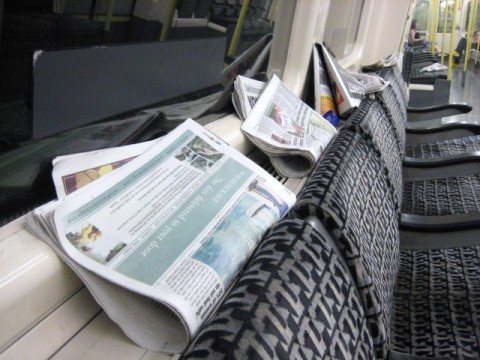You’d think that the price of something should be able to tell you what it’s worth. But ‘free’ is always so tricky – is it really free? if it’s free, what’s the catch? and if it’s truly free, maybe it’s that way because it’s actually not worth anything. Here are some case studies and questions on ‘free’.
How to prevent ‘free’ from becoming waste?
(above image) Mid-day newspaper leftovers, London Underground
While most people seem to enjoy free newspapers as a casual reading pastime, at the end of the day you’ll find them cast away, dirty and on the floor as waste. What starts out as an enterprising way to bring news to the masses for free (we won’t get into quality here) ends up being a waste management issue.
How to improve this scenario? Most free newspapers encourage recycling but don’t integrate it into the experience – their distribution points are so well located, they could easily double as recycling points too. Recycling or re-collection points could be playful to improve incentive for the public to use them, and also double as additional advertising opportunities.
How do you ensure that your mechanism for delivering ‘free’ represents the quality of what’s on offer?

Free newspaper stand in Portland, Oregon
This is an example of when ‘free’ just doesn’t look like it’s worth much. It’s a challenge to design around – how to offer a free publication, with no one paid to distribute, but make it always available to the public? This newspaper stand ends up taking a beating and risks anyone coming by and changing the message. How could this offer be improved?
How to avoid suspicion?

Free Spiritual Reading offer, Saturday Market, Portland, Oregon
What sparked my suspicion was the question mark in the same phrase as ‘free’. What was really on offer here? This was a local teenage church group offering to pray with passers-by at the market. What they’re attempting to do is to attract audiences with offering something for free.
This campaign ends up falling flat. That’s partly because the sign itself is confusing. More that that, the representative and the message just don’t match. The people associated to the sign aren’t actually prepared to deliver spiritual readings or physical healing.
These things take away my belief or interest in their offer. What could be a powerful and personalised marketing tool is confusing and disingenuous. The offer would be more authentic if the were really able to deliver what they offer – simply presenting themselves as people willing to listen to individuals and give advice would be a good start.
How to add value?

Sandpit, George Rogers Park, Oregon
This is my local park whose sandpit hosts an unofficial tradition of people bringing their unwanted old toys. A place where people already play and enjoy is made better by a good will gesture and the help of patrons. This system gives new value to unwanted items.
Why it works -
01 – The right supply for the right demand
These toys are exactly what everyone wishes they thought of bringing to the playground. No one needs them to be high quality, everyone enjoys having them there.
02 – Management is built-in
No one officially manages the sandpit toy collection. But the pool of patrons self-regulates and automatically cares enough about the well-being of the children and others to take away anything dangerous and naturally carry on the tradition by bringing their unused toys back.

